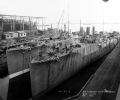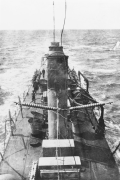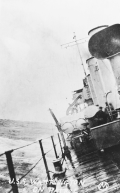Click On Image
For Full Size Image |
Size |
Image Description |
Contributed
By And/Or Copyright |
 |
33k | Lewis Warrington was born on 3 November 1782 at Williamsburg, Va. and attended the College of William and Mary briefly before accepting an appointment as a midshipman in the Navy on 6 January 1800. His first duty, in the frigate Chesapeake, took him to the West Indies where his ship cruised with a squadron during the last year of the Quasi-War with France. His ship appears to have engaged in one action near the end of the cruise. On New Year's Day 1801, she took the French privateer La Jeune Creol . Following the cessation of hostilities with France, Midshipman Warrington remained in the Navy. His ship spent most of 1801 in ordinary at Norfolk. The following year, Warrington was transferred to the frigate President for service in the Mediterranean against the Barbary pirates. Over the next five years, he remained with the Mediterranean Squadron, serving successively in President, Vixen, and Enterprise. Promoted to lieutenant in 1805, he returned home in 1807 to assume command of a gunboat at Norfolk, Va. In 1809, Lt. Warrington voyaged to Europe in Siren as a dispatch courier. He next served a tour of duty in Essex. When the war with England began in June of 1812, Warrington was in Congress serving as the frigate's first lieutenant while she patrolled the North Atlantic. During his tour of duty in that warship, she made two successful war cruises, capturing nine prizes off the east coast of the United States during the first and four off the Atlantic seaboard of South America during the second. Promoted to master commandant in July 1813, he took command of the sloop-of-war Peacock later in the year. On 12 March 1814, he put to sea with his new command bound for the naval station at St. Mary's, Ga. After delivering supplies to that installation, he encountered the British brig Epervier off Cape Canaveral, Fla. Peacock emerged victorious from a brisk 45-minute exchange with that opponent, inflicting 10 times her own losses on the enemy. For his role in the victory, Warrington received the thanks of Congress in the form of a gold medal, and of the state of Virginia in the form of a gold-hilted sword. Warrington took his prize into Savannah, Ga., and then embarked upon his second cruise on 4 June. On that voyage—which took him to the Grand Banks, the Irish coast, the Shetland Islands, and the Faroe Islands —he took 14 prizes. After returning via the West Indies to New York, Warrington took Peacock on her third and final war cruise. His sloop-of-war stood out of New York with Hornet and Tom Bowline on 23 January 1815, sailed around the Cape of Good Hope, and entered the Indian Ocean. Unaware that peace had been concluded in December 1814 at Ghent, Belgium, Warrington led his little force on another successful foray against British commerce. After taking three prizes in the Indian Ocean, he entered the East Indies in search of more game. On 30 June, he encountered the East India Company cruiser Nautilus in the Sunda Strait and attacked her. After a sharp action which cost the British ship 15 men including her first lieutenant, she surrendered to Warrington and his force. At this point, Warrington learned of the peace, and he therefore released the prize and started for home. Peacock arrived back in New York on 30 October 1815. In 1816, he commanded Macedonian briefly for a voyage to Cartagena, Spain, to convey there Christopher Hughes, the representative of the United States at negotiations over the release of some Americans imprisoned by Spanish authorities. In 1819 and 1820, Capt. Warrington commanded Java, followed by Guer-riere in 1820 and 1821. Each ship was assigned to the Mediterranean Squadron during his tenure as her commanding officer. Capt. Warrington returned home and received orders to duty at the Norfolk Navy Yard. In February 1825, he relieved Porter as commander of the West Indian Squadron during the latter stages of the piracy suppression campaign and thereafter bore the title, commodore. In 1826, Warrington returned home and served ashore for the remainder of his career. After four years in Washington—1826 to 1830—as one of three commissioners on the Navy Board, a body charged with the administration of naval materiel, Warrington returned to Norfolk for a decade as commandant of the navy yard. In 1840, he was reassigned to Washington for another two years as commissioner on the Navy Board. After the 1842 reorganization of the Navy Department, Warrington became Chief of the Bureau of Yards and Docks. On 28 February 1844, he took over temporarily the duties of the Secretary of the Navy after Secretary Thomas W. Gilmer died as a result of wounds received when the large cannon "Peacemaker" exploded during a firing demonstration on board Princeton at Washington. Near the end of March, Warrington relinquished those duties to the new secretary, John W. Mason, and resumed his former assignment. In 1846, he became Chief of the Bureau of Ordnance, which office he held until his death on 12 October 1851. Painting by Rembrandt Peale, 1801-1802, from the Minneapolis Institute of Arts. | Bill Gonyo |
 |
65k | Undated, location unknown. | Mike Green |
 |
200k | Undated, location unknown. Photo from the collection of the Vallejo Naval and Historical Museum. | Darryl Baker |
 |
120k | Undated, location unknown. Photo NH 77153, courtesy Mrs. G. C. Robbins. | Ed Zajkowski |
 |
129k | Undated photo of destroyers showing (nearest to farthest), USS Warrington (DD-30), USS Walke (DD-34) and USS Porter (DD-59) moored at Queenstown, Ireland during WWI service. Source: Imperial War Museum Ministry of Information First World War Collection, Photo No. © IWM (Q 18176). | Mike Green |
 |
105k | Undated, USS Warrington (DD-30) and USS Fanning (DD-37) location unknown. | Richard Miller BMCS USNR RET. |
 |
101k | Warrington making smoke. | Mike Green |
 |
147k | USS Warrington (DD-30) in drydock at the Philadelphia Navy Yard, circa 1919. An unidentified sub chaser is also present. Source: Naval History and Heritage Command, Photo No. NH 46282 | Mike Green |
 |
228k | USS Warrington (DD-30) under construction at the Cramp Shipyard, Philadelphia, 1 April 1910. Source: United States National Archives, Photo No. 19-N-24-24-2. | Mike Green |
 |
89k | USS Warrington (Destroyer # 30), left, and USS Mayrant (Destroyer # 31) fitting out at the William Cramp & Sons Ship & Engine Building Company shipyard, Philadelphia, Pennsylvania, 1 July 1910. Photograph from the Bureau of Ships Collection in the U.S. National Archives. | Tony Cowart |
 |
103k | USS Warrington (Destroyer # 30), left, and USS Mayrant (Destroyer # 31) fitting out at the William Cramp & Sons Ship & Engine Building Company Shipyard, Philadelphia, Pennsylvania, 1 October 1910. Source: United States National Archives, Photo No. 19-N-24-27-2 | Mike Green |
 |
88k | USS Mayrant (Destroyer # 31), left, and USS Warrington (Destroyer # 30) fitting out at the William Cramp & Sons Ship & Engine Building Company shipyard, Philadelphia, Pennsylvania, 1 July 1910. Note the exposed rudder yoke on Mayrant's stern, propeller guards, steering wheels just forward of the after gun mounts, and names afixed to the ships' sterns. Photograph from the Bureau of Ships Collection in the U.S. National Archives. | Tony Cowart |
 |
178k | USS Warrington (DD-30) in drydock continuing with fitting out, 3 January 1911, approximately two months before being commissioned. Source: United States National Archives, Photo No. 19-N-24-24-10, | Mike Green |
 |
178k | USS Warrington (DD-30) in dry dock, 3 January 1911 two months before being commissioned. Source: United States National Archives, Photo No. 19-N-24-24-8. | Mike Green |
 |
63k | Photo #: NH 77168, S.S. New York (American Passenger Liner, 1888) steaming through the war zone while operating as a troop transport in 1917 or early 1918. Photographed from on board USS Warrington (Destroyer # 30), which was escorting the transport as she approached the end of a trans-Atlantic voyage from the United States. Courtesy of Gustavus C. Robbins, 1973. U.S. Naval Historical Center Photograph. | Paul Rebold |
 |
150k | Starboard bow view of the USS Warrington (DD-30) sometime between 1910 and 1915, anchored at an unknown location. Library of Congress, LC-B2- 3456-15. | Mike Green |
 |
115k | Photo of sailors in front of USS Warrington's (DD-30) bow at the Key West depot wharf, April 9, 1914. Source: Naval History and Heritage Command, Photo No. UA 570.05 | Mike Green |
 |
46k | Photo #: NH 105118. USS Warrington (Destroyer # 30) wearing pattern camouflage, 1918, probably in Brest Harbor, France. The original image is printed on postcard ("AZO") stock. Note the long depth charge rack on Warrington's after deck. Donation of Charles R. Haberlein Jr., 2007. U.S. Naval Historical Center Photograph. | Paul Rebold |
 |
76k | USS Warrington (Destroyer # 30) off Brest, France in 1918, while painted in pattern camouflage. Courtesy of Ted Stone, 1985. U.S. Naval History and Heritage Command Photograph. Photo #: NH 100427. | Robert Hurst |
 |
95k | Sinking of USS President Lincoln, 31 May 1918 Survivors on board USS Warrington (Destroyer # 30), at left, and USS USS Smith (Destroyer # 17), at right, after they were rescued, about 1 June 1918. The donor, a member of Warrington's crew at the time, comments: "We had to transfer some men to the Smith as we had too many men to feed." Courtesy of Gustavus C. Robbins, 1973. U.S. Naval Historical Center Photograph. | Fred Weiss |
 |
134k | USS Roe (Destroyer # 24), at right, taking on oil from USS Warrington (Destroyer # 30), at sea off the coast of Brest, France, 1 June 1918. Note Warrington's pattern camouflage. U.S. Naval Historical Center Photograph. | Paul Rebold |
 |
268k | Crewmen relaxing on deck of Warrington during World War One convoy operations.
Naval History & Heritage Command photo NH 77152, Courtesy of Mr. Gustavus C. Robbins, Somerville, Massachusetts, 1973. | Mike Green |
 |
232k | USS Warrington (DD-30) underway, showing view looking aft from the bridge, taken during World War I. Note insulators for radio antennae in center.
Naval History & Heritage Command photo NH 77153, Courtesy of Mr. Gustavus C. Robbins, Somerville, Massachusetts, 1973. | Mike Green |
 |
202k | USS Warrington (DD-30) underway in rough seas showing view alongside the port side, looking forward on deck, taken while on anti-submarine patrol during World War I. Note twin-mount 18" torpedo tube.
Naval History & Heritage Command photo NH 77165, Courtesy of Mr. Gustavus C. Robbins, Somerville, Massachusetts, 1973. | Mike Green |
 |
246k | USS Warrington (DD-30) underway showing view of the ship's wake, at full speed, taken during World War I.
Naval History & Heritage Command photo NH 77158, Courtesy of Mr. Gustavus C. Robbins, Somerville, Massachusetts, 1973. | Mike Green |

